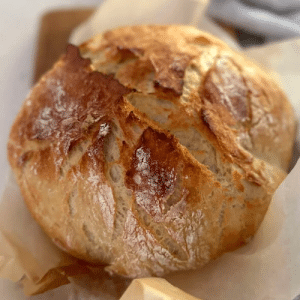
Classic Artisan Bread
Classic Artisan Bread is a beautifully rustic, no-knead bread with a crisp golden crust and a soft, airy interior. With just four simple ingredients—flour, water, salt, and yeast—this bread relies on slow fermentation to develop deep, complex flavors. The Dutch oven baking method creates a signature crunchy crust, making it the perfect homemade alternative to store-bought artisan loaves.
Equipment
- 1 Large Mixing Bowl – For mixing and fermenting the dough
- 1 Wooden Spoon or Dough Whisk – To mix the ingredients
- 1 Bench Scraper – Helps with shaping the dough
- 1 Proofing Basket or Bowl – For the final rise
- 1 Sheet of Parchment Paper – Prevents sticking during baking
- 1 Dutch Oven (with Lid) – Traps steam for a crispy crust
- 1 Kitchen Scale – Ensures precise ingredient measurements
- 1 Timer – Helps track fermentation and baking times
Ingredients
Basic Ingredients
- 3 ½ cups 420g Bread Flour (or all-purpose flour)
- 1 ½ cups 360ml Water (room temperature)
- 1 ½ teaspoons 9g Salt
- ¼ teaspoon 1g Instant Yeast
Optional Additions
- 1 tablespoon Honey or Sugar for slight sweetness
- 1 teaspoon Dried Herbs rosemary, thyme, or basil for extra flavor
- 2 tablespoons Seeds or Nuts sesame, sunflower, or walnuts for crunch
Instructions
Step 1: Mixing the Dough
- In a large mixing bowl, whisk together the flour, salt, and yeast. Gradually pour in the water while stirring with a wooden spoon until a sticky, shaggy dough forms. Cover with a damp kitchen towel and let rest for 30 minutes.
Step 2: Stretch and Fold
- Instead of kneading, use the stretch-and-fold method: pull up one side of the dough, fold it over, and rotate the bowl. Repeat 3–4 times every 30 minutes for the next 2 hours.
Step 3: First Rise (Bulk Fermentation)
- Cover the bowl and let the dough rise at room temperature for 12–18 hours until doubled in size and bubbly.
Step 4: Shaping the Dough
- Lightly flour a surface and gently shape the dough into a round loaf. Place it in a proofing basket or floured bowl, cover, and let it rise for another 1–2 hours.
Step 5: Preheat and Bake
- Preheat the oven to 475°F (245°C) with a Dutch oven inside for at least 30 minutes. Transfer the dough (with parchment paper) into the hot Dutch oven.
- Cover and bake for 30 minutes.
- Remove the lid and bake uncovered for 15–20 minutes, until golden brown.
Step 6: Cooling and Serving
- Remove from the Dutch oven and let cool on a wire rack for at least 1 hour before slicing.
Notes
- Hydration Matters: The dough is sticky but avoid adding extra flour; a high-hydration dough gives the best texture.
- Dutch Oven Alternative: If you don’t have a Dutch oven, use a baking stone and place a tray of water in the oven for steam.
- Longer Fermentation = Better Flavor: Letting the dough rise for 18 hours instead of 12 gives a more developed taste.
- Freezing Instructions: Slice the bread before freezing for easy reheating.